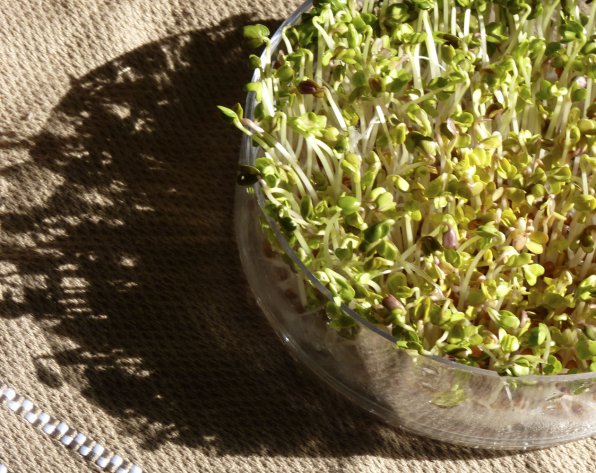Salad greens for pennies a day? Yes, it's possible – and it's easy. So easy, in fact, that I'm stumped as to why everyone's not doing it.
Growing sprouts in the kitchen, year-round, is one of the simplest and least expensive ways to incorporate fresh, organic greens into your diet. From seeds to sprouts in a matter of four or five days, you'll soon be chomping on the best quality sprouts you've ever tasted and finding new and novel ways to incorporate these nutritious mini-greens into your routines.
Like everything else you grow at home, the flavor, freshness and quality of homegrown sprouts can't be beat. Best of all, home sprouting opens up a world of varieties you'll never see in a store.
Many, many seeds of common vegetables, herbs and grains are suitable for sprouting, with just a handful that aren't, like tomatoes and eggplant, which produce toxins during germination. Members of the pea family, like mung beans, lentils, alfalfa and fenugreek (and peas, of course) are easy and tasty. Radishes, broccoli, kale, onion, lettuce, spinach, parsley and clover are all easy and quick to sprout, and are packed with flavor and nutrition. Cereals, including, wheat, oats, rice, barley, rye, kamut and quinoa can all be sprouted as well. Oil-rich seeds like sunflower and sesame are delicious as sprouts. The list goes on and on. If you can eat it as a plant, it's worth wondering if you can eat it as a sprout.
Commercial sprouts have been in the news lately for bacterial contamination, usually a function of large scale production. The easiest way to ensure safe kitchen sprouting is to buy seeds specifically marketed for sprouting and follow a few simple rules to avoid growing bacteria by mistake.
Each tiny seed carries everything a plant will need for the first few weeks of its existence. It's an energy powerhouse, just waiting to explode to life. They're loaded with vitamins, minerals, phytochemicals, amino acids and proteins. As germination happens, complex starches are broken down into simple components from which the plant will grow, grow, grow – -until the tiny plant begins drawing nutrients from the soil.
Most familiar to salad lovers are alfalfa sprouts, the tiny and mild sprouts of salad bars and sandwiches everywhere. But that's just the beginning – -the variety of seeds suitable for sprouting is colorful, with flavors ranging from mildly zesty to downright spicy.
In my pantry right now are: alfalfa, mustard, kale, radish, fenugreek, onion and more. Sometimes I mix and match; sometimes I monocrop. With such a short growing time, I can follow my sprouting whims. Some seeds benefit from presoaking; most can just do with a quick rinse before sprouting. A variety of sprouting seeds are available at the Concord Cooperative Market and even more online at seed suppliers like Johnny's Selected Seeds (johnnyseeds.com).
Equipment can be simple or fancy. I've used sprouting jars with mesh covers (or a jar with a cloth napkin secured by an elastic band), that you just rinse and drain once or twice a day. My favorite gadget for years has been a three-tiered sprouter called Bioset, available online at Johnny's. With this set-up, I can be sure my seeds will never be soaking in water and will get plenty of air. Perhaps most important, it makes rinsing so easy that I don't skip doing it.
A few tips for safe and successful sprouting:
Wash your sprouting apparatus every time – with soap.
Rinse at least once a day; twice is better.
Never let your seeds stand in water.
Know the source of your seeds; inadvertently using chemically-treated seeds could introduce toxins to your salad. Not worth the risk!
Keep your sprouter out of direct sunlight, but in a location that will remind you to rinse at least once daily. I keep mine right by the sink; I can easily rinse often, monitor progress and harvest the sprouts when they're exactly ready. You'll know when they're ready. They'll be big, crispy, with green cotyledons (the tiny pair of new leaves) and white roots.
Rinse your harvest in a colander and drain well. I store my sprouts in the refrigerator in a covered container with a napkin folded at the bottom to catch excess moisture. If I start another batch right away, I'm just running out of sprouts when my new batch is ready to harvest.
Once you're up to your ears in sprouts, you'll find new and exciting things to do with them. They're beautiful and delicious atop a bowl of soup or a baked potato. Sprouts pack a delicious punch in a green smoothie and are at home in any sandwich, not to mention salads, of course.
My current favorite sprout is radish, for its zing and crunch, but ask me next week and I'll likely have moved on to another favorite.
Sprouting is urban farming at its best, right on the kitchen counter. Empower yourself by growing your own sprouts, and you'll never be without fresh greens again.
Eleanor Baron lives, gardens, cooks and writes in Concord and stalks area farmers markets for fresh, in-season produce. She has a special passion for the more unusual, less appreciated “underdog” vegetables. Visit her blog at nourishingwords.net for more ideas and inspiration on incorporating healthy habits into your life.










